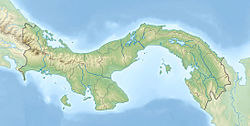| Cucaracha Formation | |
|---|---|
| Stratigraphic range: Early Burdigalian-Mid Langhian (Hemingfordian-Barstovian) | |
| Type | Formation |
| Underlies | Pedro Miguel & La Boca Formations |
| Overlies | Culebra Formation |
| Thickness | ~125 m (410 ft) |
| Lithology | |
| Primary | Sandstone, conglomerate |
| Other | Claystone |
| Location | |
| Coordinates | 9°00′N79°36′W / 9.0°N 79.6°W |
| Approximate paleocoordinates | 8°24′N77°30′W / 8.4°N 77.5°W |
| Region | Panamá Province |
| Country | Panama |
| Extent | Panama Basin |
The Cucaracha Formation (Tca) [1] is a geologic formation in Panama. It preserves vertebrate and plant fossils dating back to the Neogene period; Early to Middle Miocene epochs (Hemingfordian). [2] Fossils of the crocodylian Centenariosuchus , the turtle Rhinoclemmys panamaensis and the artiodactyl Paratoceras have been found in the formation. [3]
Contents
The Cucaracha Formation is approximately 125 metres (410 ft) thick, [4] and dated to 19 to 14 Ma. [5]





